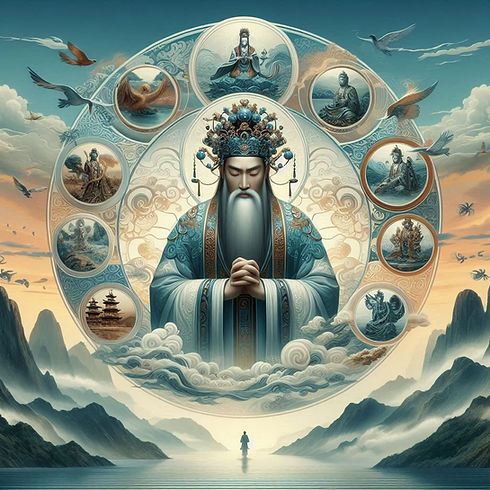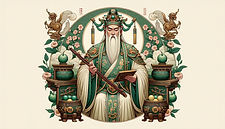

Chinese Folk Religion
Ancient Tradition
Place of Origin: China
Founded in: Ancient times (Evidence shows practices date back to the Yangshao Culture (5000-3000 BCE) in the Yellow River Valley)
Major Figures:
-
Jade Emperor: Supreme ruler of Heaven.
-
Mazu: Goddess of the Sea.
-
Guan Yu: God of War and Righteousness.
-
Tu Di Gong: Earth God.
-
Zao Jun: Kitchen God.
Major Festivals:
-
Lunar New Year: A major celebration marking the beginning of the lunar calendar, with various rituals and festivities.
-
Qingming Festival: Also known as Tomb Sweeping Day, a time for people to honor their ancestors by visiting their graves and making offerings.
-
Mid-Autumn Festival: A harvest festival celebrated with mooncakes and lanterns, and a time for family reunions.
-
Hungry Ghost Festival: A time to honor and appease wandering spirits, with offerings and rituals to ensure their peace.
-
Dragon Boat Festival: Celebrated with dragon boat races and the eating of zongzi (sticky rice dumplings), in honor of the poet Qu Yuan.
Origins and Early Development
Chinese Folk Religion is a rich and ancient tradition that has evolved over thousands of years. Its origins date back to prehistoric times, with evidence of practices found in the Yangshao Culture (5000-3000 BCE) in the Yellow River Valley. These early practices included ancestor worship, nature worship, and rituals to ensure harmony between humans and the natural world.
Ancient Tradition:
Chinese Folk Religion is an ancient tradition that developed organically over millennia, incorporating elements from various belief systems, including Taoism, Confucianism, and Buddhism. It reflects the syncretic nature of Chinese spirituality, blending indigenous beliefs with philosophical and religious influences.
Key Texts:
-
Classic of Mountains and Seas (Shan Hai Jing): A compilation of mythical geography and legends.
-
Records of the Grand Historian (Shiji): Historical records that include references to deities and religious practices.
-
Dao De Jing: A fundamental text of Taoism that has influenced Chinese Folk Religion.
Deities/Key Figures:
-
Jade Emperor: Supreme ruler of Heaven.
-
Mazu: Goddess of the Sea.
-
Guan Yu: God of War and Righteousness.
-
Tu Di Gong: Earth God.
-
Zao Jun: Kitchen God.
Growth:
Chinese Folk Religion grew organically as a central part of Chinese culture and daily life. It flourished through various dynasties, adapting and integrating new elements while retaining core practices. The religion remained resilient even during periods of political and social upheaval.
Core Beliefs:
-
Ancestor Worship: Reverence for ancestors and belief in their ongoing influence in the lives of the living.
-
Harmony with Nature: Maintaining balance and harmony between humans, nature, and the cosmos.
-
Syncretism: Integration of beliefs and practices from Taoism, Confucianism, and Buddhism.
-
Deity Worship: Veneration of various gods, goddesses, and spirits associated with different aspects of life.
Rituals and Practices:
-
Offerings and Prayers: Rituals to honor ancestors and deities, often involving incense, food, and symbolic items.
-
Festivals: Celebrations such as the Lunar New Year, Qingming Festival, and Mid-Autumn Festival.
-
Divination: Practices like Feng Shui and I Ching used to predict and align with natural forces.
Symbol:
-
Yin-Yang: Represents the balance of opposites and the interconnectedness of all things in the universe.
Cultural Impact:
Chinese Folk Religion has had a profound influence on Chinese art, literature, architecture, and social customs. It has shaped cultural practices, festivals, and the values of Chinese society. Temples, shrines, and traditional rituals continue to be an integral part of community life.
Global Presence:
Chinese Folk Religion is primarily practiced in China and among Chinese communities worldwide. It has a significant presence in Taiwan, Hong Kong, Singapore, Malaysia, and other countries with substantial Chinese populations.
Enduring Legacy:
Chinese Folk Religion remains a vital and enduring aspect of Chinese culture. Its core beliefs and practices continue to be passed down through generations, adapting to modern contexts while preserving ancient traditions. It serves as a living connection to China's rich spiritual heritage and cultural identity.
Historical Timeline
Divine Figures
The pantheon of divine deities in Chinese folklore religion is vast and diverse, encompassing gods, goddesses, mythical heroes, ancestors, and spirits. This extensive array reflects the rich tapestry of mythology, tradition, and cultural beliefs that vary widely by region and community. It is challenging to determine an exact number of deities, with some estimates suggesting hundreds, if not thousands, worshipped across China and in Chinese communities worldwide. This diversity highlights the unique blend of local traditions, historical influences, and cultural syncretism characterizing Chinese folk religion.











